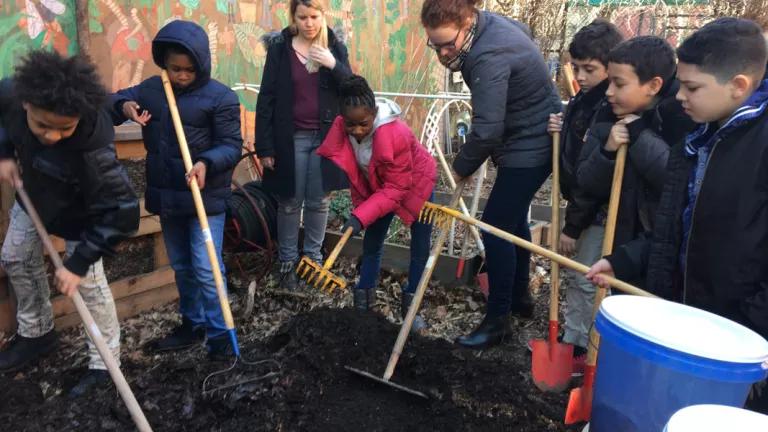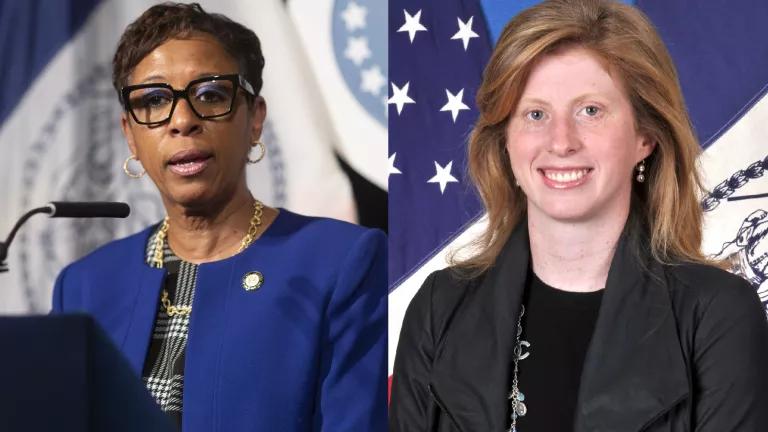NYC Moves Modestly to Restore Composting; More Is Needed
The DeBlasio Administration, seeking to dispel criticism that it broke one of its cornerstone sustainability promises, has announced plans to restore voluntary food waste composting opportunities in the nation’s largest city.

DeBlasio to resume voluntary curbside food waste collections; but long term success requires mandatory legislation.
The DeBlasio Administration, seeking to dispel criticism that it broke one of its cornerstone sustainability promises, has announced plans to restore voluntary food waste composting opportunities in the nation’s largest city.
While the City Hall announcement would expand opportunities for New Yorkers to deposit their food scraps into composting bins at curbside or neighborhood drop-off sites, the new plans fall short of what is necessary to capture the bulk of the city’s food scraps and keep this waste from being shipped to methane-generating landfills that are worsening the climate crisis.
Under the newly announced voluntary program, residential building managers and homeowners in parts of the city that received food scrap collections at curbside before the program was suspended last spring will be eligible for collections starting in October. To receive food scrap pick-ups, residents will be required to affirmatively enroll or re-enroll in the program.
But the new curbside collection initiative has critical flaws that will limit its effectiveness.
The biggest problem is that the new program will be voluntary and only buildings that were in sections of the city covered by the earlier program will be eligible participate.
Without introducing legislation that would make the program mandatory in future years for all households, the Administration is advancing a limited strategy that will be unlikely to capture the overwhelming bulk of food scraps (and yard waste) generated by city residents.
Since the previous curbside program was voluntary and had other operational challenges, participation even in covered neighborhoods was low. According to the Sanitation Department’s most recent waste characterization study, in 2017, only 13,000 tons of food scraps, yard waste and food-soiled paper were collected in the curbside program—about 2% of all potentially compostable waste picked up by the Department that year.
Moreover, the Administration has had no public engagement process to examine what worked and what didn’t in the original curbside food scraps pilot or what if any changes it will be making in the new voluntary program to ensure that this second demonstration will be more effective in capturing these organics or in reducing food scrap collection costs.
Limitations of the new program slice some districts out of eligibility for curbside collections. This could delay many lower-income neighborhoods and residents from the option of receiving curbside food scrap collection services. Environmental justice advocates rightly note that this could have the effect of denying an important municipal service to communities of color that are already getting the short end of the stick when it comes to environmental benefits.

As City Hall bumbles, LES Ecology Center and Big Reuse composting sites remain threatened with eviction.
The Mayor also announced that the city will expand the number of neighborhoods sites where New Yorkers can drop off food scraps from about 100 to 200 in the months ahead. This effort will benefit the City’s community composting program, which also had its funding slashed last spring.
Community composting has numerous environmental and social benefits and should receive continuing support even if the City Council ultimately enacts a mandatory food scrap separation and curbside collection law that covers all neighborhoods in each of the five boroughs.
But expanding the number of neighborhood drop-off sites won’t mean much if there isn’t processing capacity nearby to turn these food scraps into finished compost.
And the Mayor’s announcement has failed to resolve the number one problem facing community composting today: the pending eviction of two beloved non-profit organizations—Big Reuse and the LES Ecology Center—from their successful compost processing sites on Parks Department properties.
Despite months of protest from the Save Our Compost coalition, from diverse constituencies across all five boroughs, and from city, state and federal elected officials, the DeBlasio Administration has stubbornly insisted on forcing Big Reuse out of its current location under the Queensboro Bridge and ejecting LES Ecology Center from East River Park.
Why Mayor DeBlasio has not stepped up to rescue these efficient and widely admired composting operations remains a mystery.
Some will see the Mayor’s latest composting announcement as a modest step in the right direction that could begin to fulfill the Administration’s pledge to bring curbside composting collection and enhanced drop-off sites to every city neighborhood. Others will conclude this is a poorly designed initiative that was rushed out the door in time for Earth Day.
What seems clear, however, is that without more ambitious efforts, backed by City Council legislation, the Mayor's promise of sustainably handling the thousands of tons of food scraps, food soiled paper and yard waste generated every day by New Yorkers will remain a distant dream.
In Parts Two and Three of this blog, we will suggest next steps the City can take to resolve the organics waste challenge and become a national leader in sustainable food waste handling.




